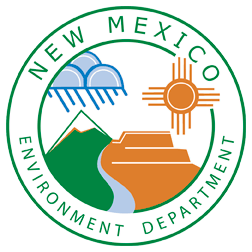Thermo Eberline Facility
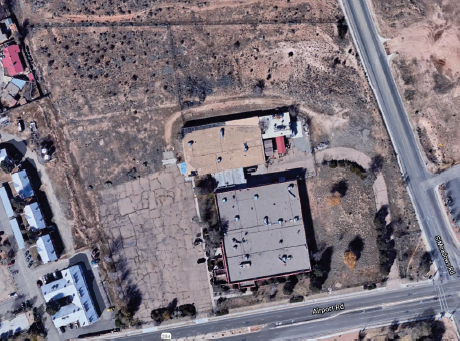
Company Name / Public Involvement: Thermo Eberline LLC
License Number: SO067
Date Posted: 7/24/2025
Location: 5981 Airport Road
Santa Fe, NM 87507
Full Thermo Eberline LLC Decommissioning Plan
- Decommissioning Plan Overview & Summary
- Dated 05/28/2025 Submittal Letter Final Decommissioning Plan (PDF)
- Purpose & Scope, Facility Operating History, & Description
- Radiological Status of Facility, Dose Modeling, ALARA Analysis, and Planned Decommissioning Activities
- PM & Organization, Health & Safety During Decomm, Environmental Monitoring & Control
- Radioactive Waste Management, Quality Assurance, & Facility Radiation Surveys
- Financial Assurance
- *Glossary of Acronyms & Abbreviations
- *Supporting Documentation & Attachments
Executive Summary
This decommissioning plan (DP) is being submitted in support of termination of Radioactive Materials License SO067-36 issued to Thermo Eberline LLC (Company/Licensee) by the New Mexico Environment Department (NMED), Radiation Control Bureau (RCB). This DP includes updates to the DP submitted to NMED dated January 31, 2025 in response to NMED review and comment and Licensee responses included in Appendix G.
The license was issued on December 20, 2022, for the storage of any remaining radioactive materials pending decommissioning of the facility located at 5981 Airport Road, Santa Fe, New Mexico 87507 (site, Figure 1- 1). The license expires December 31, 2027. The owner of the site is Thermo Eberline LLC, with a business address of 27 Forge Parkway in Franklin, MA 02038.
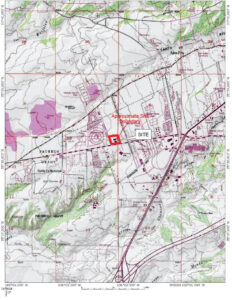
The site is 11.4 acres and contains three structures totaling 66,600 square feet (sft) including: 1) a main South Building that is 41,600 sft, constructed in 1968; 2) the North Building, or Engineering Annex, a 22,275 sft addition to the South Building, constructed in 1978; and 3) a Middle Building, 2,725 sft, constructed with the North Building in 1978 that covers a loading dock and adjacent storage rooms connecting the North and South Buildings (Figure 3-2).
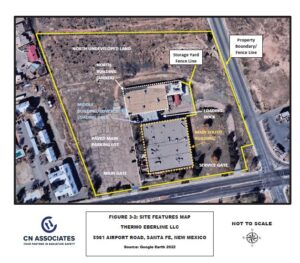
The immediate area surrounding the buildings is landscaped, paved with asphalt, or covered with concrete and includes the main parking lot and a storage yard within a fenced area to the east of the loading dock (Figure 3- 2). The rear, north half of the property remains undeveloped. A dirt drive wraps around the north end of the North Building. The entire site is surrounded by a chain-link fence and guarded by 24/7 security.
The site is located within the Santa Fe city limits and is currently zoned as light industrial by the City of Santa Fe (Figure 3-3).
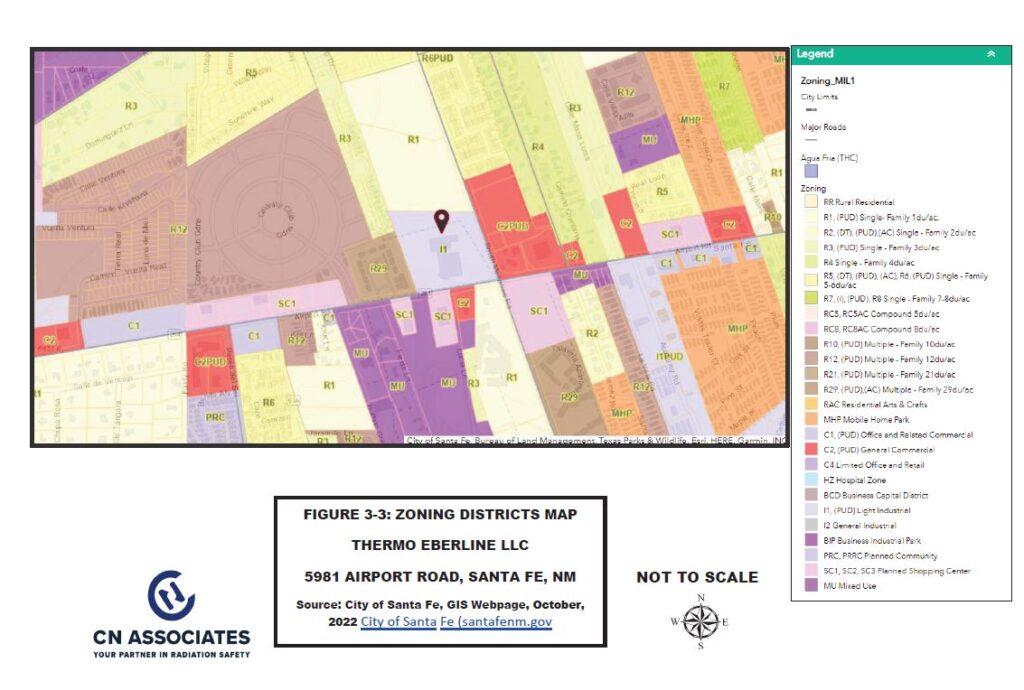
The surrounding properties are zoned residential with mixed commercial and include (Figure 3-4):
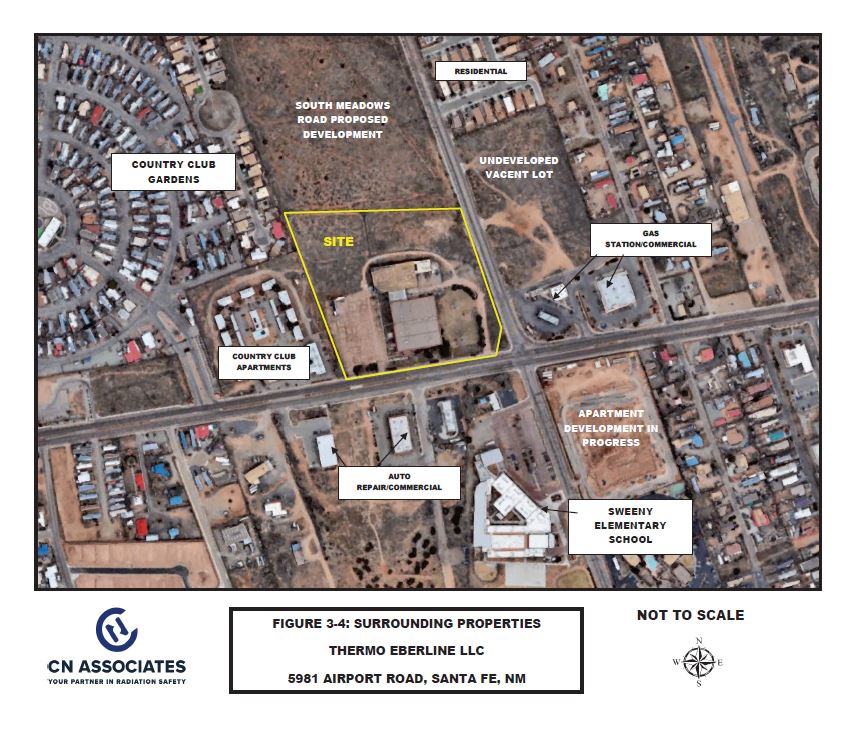
- Vacant land abuts the north boundary, recently re-zoned to allow development and construction of residential dwellings and a park (Homewise Los Prados development).
- South Meadows Road abuts the property to the east, beyond which is a commercially zoned property developed with a gas station. Land along South Meadows Road includes a vacant lot and residential properties.
- Airport Road abuts the property to the south, across which lie commercial and residential properties and a school (Sweeney Elementary School).
- Single and multi-family residential dwellings abut the property to the west (Country Club Apartments/Country Club Gardens).
Operations at the site included research and development, manufacturing, service and repair, calibration, and distribution of radioactive monitoring instruments. The Licensee (formerly Eberline Instrument Corporation (Eberline)) was originally licensed to possess, use, receive and transfer radioactive materials under License Number GL 263 issued by the United States Atomic Energy Commission (AEC) in 1968. Eberline, and then the Company, was subsequently licensed under License # NM-EBE-BL-00 issued by the New Mexico Environment Improvement Agency (EIA), then later under License # CS067 issued by the NMED RCB, and most recently under license SO067-36 issued for storage and handling for disposal.
In June 2007, the Licensee notified the NMED RCB of its decision to cease principal manufacturing operations at the facility. The process of removing all licensed radioactive materials, sending the materials to other licensed facilities for productive use or to licensed disposal sites began in 2007 and was largely completed by 2016.
The site has been undergoing characterization and interim cleanup since 2007. Results of those efforts have confirmed no impact from licensed radioactive materials to buildings, their contents, exterior ground surfaces (soil, asphalt and concrete) and groundwater. Licensed radioactive materials remaining on site are limited to three defined areas of residues in subsurface soil (Figure 2-1): one area of subsurface soil beneath the main South Building originating from a breached Cesium 137 (Cs-137) source and two shallow soil areas near the former loading dock from naturally occurring uranium ore found in soil. Based on the amount of residual radioactivity remaining, its location, the complexity of the site, and confirmation of no impact to groundwater from licensed radioactive materials, decommissioning will proceed as a Group 4 in accordance with NUREG-1757, Consolidated Decommissioning Guidance.
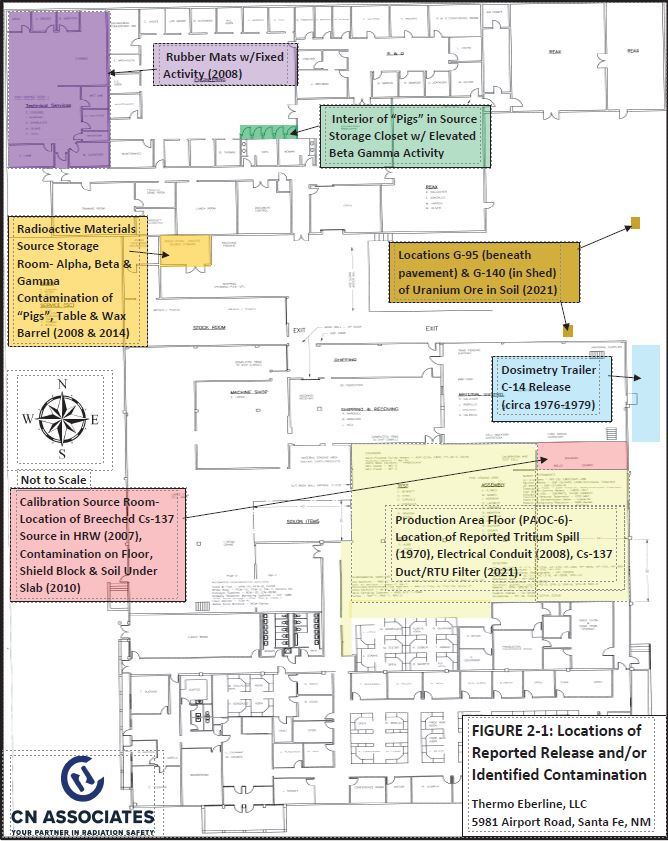
Derived Concentration Guidelines Levels (DCGLs) for licensed radionuclides at the site are proposed as cleanup criteria based on the adaptation of conservative screening criteria issued by NMED for building surfaces to manmade land surfaces (concrete, asphalt) and soil. The proposed DCGLs correspond to a Total Effective Dose Equivalent (TEDE) of 15 millirem per year (mrem/yr) as opposed to the 25 mrem/yr TEDE required under New Mexico Administrative Code (NMAC) to ensure protection for unrestricted release. This lower dose limit of 15 mrem/yr represents a 40 percent reduction in the required dose limit and was voluntarily accepted by the Licensee at NMED’s request to provide NMED and the public an added level of confidence that site restoration will not only meet, but exceed, regulatory standards for protection of the public and ensure safe future use of the property following license termination.
Under this DP the Licensee is proposing to remediate the site to achieve background levels of Cs-137 and naturally occurring uranium by removal of the site buildings, structures and impacted soils. Achievement of background is the highest level of restoration technically feasible as it ensures a greater level of protection than the 15 mrem/yr TEDE and meets the ALARA (As Low As Reasonably Achievable) standard.
Site decommissioning will commence following receipt of NMED approval and a license amendment to add the DP to the license. Site decommissioning will include three phases of work that will be sequenced based on weather, timing and progress to complete the work in a safe, reliable and expeditious manner:
- Phase 1 includes the demolition and disposition of non-impacted site buildings and contents (excluding foundations). Phase 1 will be the first phase of decommissioning work to be initiated at the site following NMED approval.
- Phase 2 includes demolition and disposition of non-impacted building foundations, concrete, and asphalt surfaces (i.e., Land Surfaces). Soil beneath removed surfaces will be subject to characterization surveys following removal. Any impacts discovered lying beneath concrete or asphalt surfaces will be remediated under Phase 3.
- Phase 3 includes removal of a small, impacted portion of the building foundation adjacent to defined areas of impacted soil from Cs-137, removal of Cs-137 impacted soil and removal of residues of naturally occurring uranium ore in soil in two locations. Any other soil impacts discovered beneath foundations, concrete or asphalt surfaces, if present, will also be addressed during Phase 3.
The three primary phases of work will be sequenced by location to enable concurrent progress of work elements and the appropriate monitoring and controls to ensure safe, reliable and expeditious execution of the work. For example, Phase I demolition will begin with removal of that portion of the main South Building in the area overlying the Cs-137 impacted soil to enable access for Phase 3 soil remediation. This will enable the setup of controls (including a tent for containment) and for removal of the slab and underlying Cs-137 impacted soil under Phase 3 while work progresses on Phases 1 and 2 building and slab demolition in other portions of the site.
Once all three phases of the site work are complete, wastes are properly packaged and disposed off-site, and remediation of impacts to background (as feasible) are confirmed, a final survey and testing of site soil and groundwater will be completed under the Final Status Survey (FSS) process in NUREG-1757 to confirm compliance with background, or a 15 mrem/yr TEDE (if achievement of background is not feasible). Achievement of background or the 15 mrem/yr dose limit will ensure protection during future unrestricted use of the site. A Decommissioning Report (DR), summarizing the results of site decommissioning, documenting the results of the FSS and including a request for license termination, will be submitted within 24 months of initiating site decommissioning.
